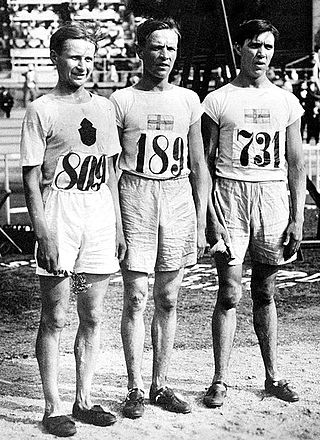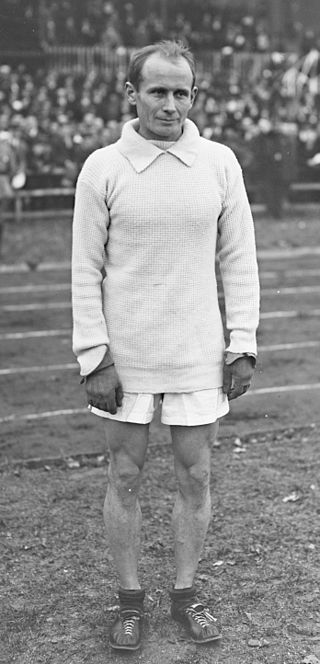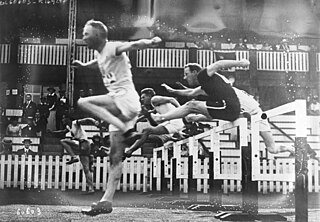
The 1920 Summer Olympics, officially known as the Games of the VII Olympiad and commonly known as Antwerp 1920, were an international multi-sport event held in 1920 in Antwerp, Belgium.

Cross country running is a sport in which teams and individuals run a race on open-air courses over natural terrain such as dirt or grass. The course, typically 3–12 kilometres (1.9–7.5 mi) long, may include surfaces of grass and earth, pass through woodlands and open country, and include hills, flat ground and sometimes gravel road and minor obstacles. It is both an individual and a team sport; runners are judged on individual times and teams by a points-scoring method. Both men and women of all ages compete in cross country, which usually takes place during autumn and winter, and can include weather conditions of rain, sleet, snow or hail, and a wide range of temperatures.

France competed at the 1920 Summer Olympics in Antwerp, Belgium. 304 competitors, 296 men and 8 women, took part in 113 events in 23 sports.

Sweden competed at the 1920 Summer Olympics in Antwerp, Belgium. 260 competitors, 247 men and 13 women, took part in 100 events in 18 sports.

The United States competed at the 1920 Summer Olympics in Antwerp, Belgium. 288 competitors, 274 men and 14 women, took part in 113 events in 18 sports.

Finland competed at the 1920 Summer Olympics in Antwerp, Belgium for the first time as a fully independent state. It competed independently in 1908 and 1912 as the autonomous Grand Duchy of Finland within the Russian Empire. 63 competitors, 62 men and 1 woman, took part in 51 events in 9 sports.

The Netherlands competed at the 1920 Summer Olympics in Antwerp, Belgium. 130 competitors, 129 men and 1 woman, took part in 58 events in 15 sports.

The men's 2590 metres steeplechase was a track and field athletics event held as part of the Athletics at the 1904 Summer Olympics programme. It was the only time the event was held at the 2590 metre distance, though the 1900 Summer Olympics had featured a similar event in the 2500 metre steeplechase. The competition was held on August 29, 1904. 7 athletes from 2 nations competed. Jim Lightbody of the United States won the first of his three gold and four overall medals in the 1904 Games. Irishman John Daly took silver, with Lightbody's countryman Arthur L. Newton earning bronze.

At the 1912 Summer Olympics, the men's individual cross country race was held as part of the athletics programme. It was the first appearance of the event. The competition was held on Monday, July 15, 1912. Forty-five runners from nine nations competed. NOCs could enter up to 12 athletes.

The men's 200 metres event was part of the track and field athletics programme at the 1920 Summer Olympics. The competition was held on Thursday, August 19, 1920, and on Friday, August 20, 1920. Forty-eight sprinters from 22 nations competed. Nations were limited to 4 athletes each, down from the 12 allowed in previous Games. The event was won by Allen Woodring of the United States, the nation's second consecutive victory in the event and fourth in five Games. Fellow American Charley Paddock took silver. Great Britain reached the podium for a second consecutive Games with Harry Edward's bronze.
The men's 400 metres event was part of the track and field athletics programme at the 1920 Summer Olympics. The competition was held on Thursday, August 19, 1920, and on Friday, August 20, 1920. 37 runners from 16 nations competed. No nation had more than 4 runners, suggesting the limit had been reduced from the 12 maximum in force in 1908 and 1912. The event was won by Bevil Rudd of South Africa, the nation's first title in the event. Nils Engdahl's bronze was Sweden's first medal in the 400 metres.
The men's 800 metres event was part of the track and field athletics programme at the 1920 Summer Olympics. The competition was held from Sunday, August 15, 1920, to Tuesday, August 17, 1920. Forty runners from 17 nations competed. No nation had more than 4 runners, suggesting the limit had been reduced from the 12 maximum in force in 1908 and 1912. The event was won by Albert Hill of Great Britain, snapping a three-Games streak of American victories and starting a four-Games streak of British wins. Bevil Rudd, the 400 metres winner in 1920, took bronze to give South Africa its first medal in the 800 metres.
The men's 1500 metres event was part of the track and field athletics programme at the 1920 Summer Olympics. The competition was held on Wednesday, August 18, 1920, and on Thursday, August 19, 1920. Twenty-nine runners from 12 nations competed. No nation had more than 4 runners, suggesting the limit had been reduced from the 12 maximum in force in 1908 and 1912. The event was won by Albert Hill of Great Britain, completing his middle-distance double. It was the nation's second consecutive and third overall championship in the men's 1500 metres.
The men's 5000 metres event was part of the track and field athletics programme at the 1920 Summer Olympics. The competition was held on Monday, August 16, 1920, and on Tuesday, August 17, 1920. Thirty-eight runners from 16 nations competed.

The men's marathon event was part of the track and field athletics programme at the 1920 Summer Olympics. The distance of this race was 42.75 kilometres. The competition was held on Sunday, 22 August 1920. 48 runners from 17 nations competed. No nation had more than 4 runners, suggesting the limit had been reduced from the 12 maximum in force in 1908 and 1912. The event was won by Hannes Kolehmainen of Finland, the nation's first Olympic marathon medal and victory; Kolehmainen received his fourth gold medal, having won the 5000 metres, 10,000 metres, and individual cross country in 1912. Estonia and Italy also won their first marathon medals.

The men's 110 metres hurdles event was part of the track and field athletics programme at the 1920 Summer Olympics. The competition was held on Tuesday, August 17, 1920, and on Wednesday, August 18, 1920. 24 runners from 15 nations competed. No nation had more than 4 runners, suggesting the limit had been reduced from the 12 maximum in force in 1908 and 1912. The event was won by Earl Thomson of Canada in world record time, the first victory by any nation other than the United States in the men's 110 metres hurdles and the first time that any non-U.S. nation had even been on the podium since 1896. Thomson, who had lived in the United States since age 8, had wanted to run for the U.S. team but was ineligible due to his Canadian citizenship. A British flag was displayed at the medal ceremony rather than a Canadian one because the organizing officials did not have the appropriate flag.

The men's 400 metres hurdles event was part of the track and field athletics programme at the 1920 Summer Olympics. The competition was held on Sunday, August 15, 1920, and on Monday, August 16, 1920. 19 runners from 9 nations competed. Nations were limited to 4 hurdlers each. The event was won by Frank Loomis of the United States, the fourth consecutive victory by an American. The United States secured its second sweep in the event, and first with other nations competing, with John Norton taking silver and August Desch bronze.
The men's 3000 metres steeplechase event was part of the track and field athletics programme at the 1920 Summer Olympics. The competition was held on Wednesday, August 18, 1920, and on Friday, August 20, 1920. Sixteen runners from six nations competed.
The men's 3000 metres team event was part of the track and field athletics programme at the 1920 Summer Olympics. It was the second appearance of a 3000-metre team race event after the debut in 1912, but the fifth time that a team contest was arranged at the Olympics. The competition was held on Saturday, August 21, 1920, and on Sunday, August 22, 1920. 31 runners from six nations competed.
The men's team cross country event was part of the track and field athletics programme at the 1920 Summer Olympics. It was the second appearance of this event. The competition was held on Monday, August 23, 1920.












